Hyundai Santa
Fe Rear Brake Pads Replacement Guide
How to replace the rear brake pads on a
2007 to 2012 Hyundai Santa Fe SUV with picture illustrated instructions.
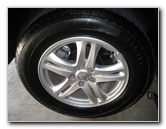 Santa Fe Rear Wheel |
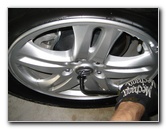 Loosen Lug Nuts |
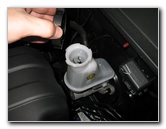 Remove Brake Reservoir Cap |
| This
automotive "how-to" guide was specifically written to assist owners
of the 2nd generation 2007, 2008, 2009, 2010, 2011 & 2012 Hyundai Santa Fe SUV in replacing
the rear brake pads. Owners of other Hyundai or Kia vehicles such as the Tucson, Veracruz, Accent, Elantra, Veloster, Sonata, Azera, Genesis, Equus, Forte, Optima, Sorento, Rio, Soul, Sportage and Sedona may also find this guide to be helpful. To complete this rear brake job, you'll need the following items: a floor jack, jack stands, a lug nut wrench, a 14mm socket or wrench, a "C" or "F" clamp, and a set of new rear brake pads. A few compatible sets of new rear brake pads with their part numbers are as follows: Wagner QC1284, Wagner ZD1284, Bosch BP1284, Akebono ACT1284, Bosch BE1284, Power Stop 16-1284, Raybestos SGD1284C & Callahan CP10077B. |
||
|
|
||
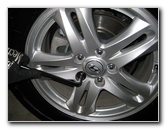 Remove Rear Wheel |
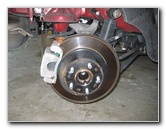 Rear Brake Rotor & Caliper |
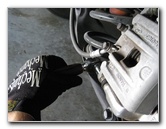 Loosen 14mm Caliper Bolt |
| First slightly
loosen the lug nuts on the rear wheel and remove the cap on the brake fluid
reservoir in preparation for compressing the caliper piston later in the
process. (The lug nut wrench is located under a carpeted panel in the cargo
area.) Then raise up the rear of the vehicle with a floor jack, securely support it with at least two jack stands and chock the front wheels with wood blocks or bricks to prevent them from moving. Spin off the five lug nuts, pull off the rear wheel and set it aside in a safe place. Behind the wheel you'll see the rear brake caliper, rotor and caliper bracket. Locate the lower caliper bolt on the back side of the caliper and remove it with a 14mm socket or wrench. |
||
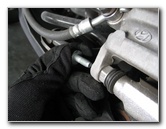 Remove Lower Caliper Bolt |
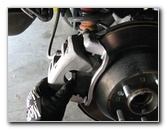 Swing Up Caliper |
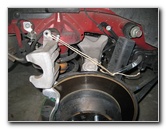 Tie Caliper To Suspension |
| Carefully swing the
caliper upwards off the old brake pads and the rotor.
Secure the caliper in the upward position by tying it to a suspension component with some twine or rope. This will prevent the caliper from crashing down on your fingers or the rotor while you are replacing the brake pads. |
||
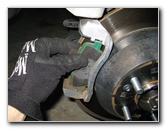 Wiggle Off Old Pads |
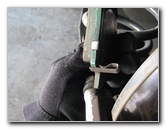 Wear Indicator Bar |
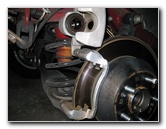 Old Brake Pads Removed |
| Pull the old brake
pads away from the rotor and out of the caliper bracket.
Make a mental note of where the wear indicator or "squeal" bar is located. On this Hyundai Santa Fe, the wear indicator bar was situated at the bottom of the inner brake pad. I recommend buying the Wagner ThermoQuiet QC1284 brake pads since they have excellent reviews on Amazon. I also love how they don't require any backing plates or shims due to the built in insulators. Plus they are true to their name as far as being quiet. |
||
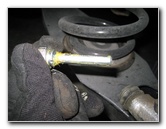 Remove Caliper Pin |
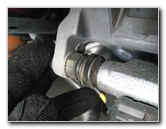 Check & Lubricate Pins |
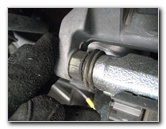 Upper Pin Moving Freely |
| Remove the lower
caliper pin from its rubber dust boot and check that it is adequately
lubricated. If the lower caliper pin is well greased, re-install it into the
dust boot and also verify that the upper caliper pin moves freely.
If the lower caliper pin wasn't well lubricated, apply some high pressure and temperature brake caliper grease to both the upper and lower caliper pins. |
||
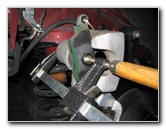 Compress Caliper Piston |
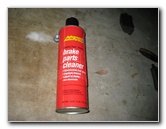 Brake Parts Cleaner Spray |
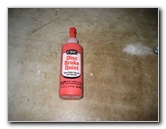 CRC Disc Brake Quiet Gel |
|
|
||
| In order for the
caliper to fit over the thicker new rear brake pads, the caliper piston will
need to be compressed backwards with a "C" or "F" clamp.
Attach the "C" or "F" clamp to the caliper using an old brake pad to help evenly compress it. The cap on the brake fluid reservoir should already be removed to allow the fluid to easily travel through the system when the piston is compressed. Slowly compress the piston while repeatedly checking the brake fluid level in the reservoir to keep it from overflowing. Only compress the piston as far back until it is flush with the rubber dust boot. Clean off the rotors, caliper and caliper bracket with some brake parts cleaner spray. To help prevent braking noise, apply some CRC Disc Brake Quiet gel or a similar product to the rear of the brake pads where they come in contact with the caliper.
|
||
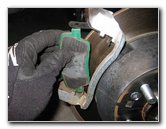 Install New Brake Pads |
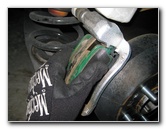 Push Flush Against Rotor |
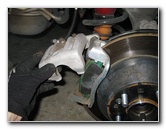 Lower Down Caliper |
| Insert the new rear
brake pads into the caliper bracket, cut the twine supporting the caliper
and lower it down over the new brake pads.
If the caliper won't fit over the new pads, compress the caliper piston a bit more using the "C" clamp. |
||
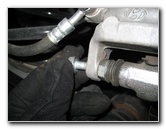 Insert Lower Caliper Bolt |
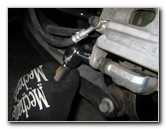 Tighten Caliper Bolts |
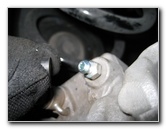 Brake Line Bleeder Valve |
| Line up the bolt
hole in the caliper with the caliper pin in the bracket and insert the lower
caliper bolt.
Tighten the bolt using the 14mm socket with ratcheting wrench to just past hand tight. If you have a torque wrench, tighten both caliper bolts to about 25-30 ft lbs. If your brake pedal previously felt mushy or spongy, the brake fluid may be contaminated with water or the brake lines may contain air bubbles. It would be best to bleed the brake lines at this time to flush out the old brake fluid and replace it with new DOT 3 brake fluid. For more on this topic, check out my Brake Line Fluid Bleeding Guide. |
||
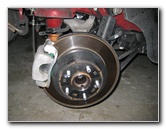 Rear Brake Job Complete |
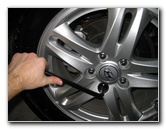 Replace Lug Nuts |
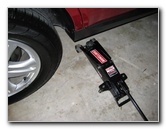 Lower From Jack Stands |
| Double check that
both the caliper bolts are on tight before replacing the rear wheel and
spinning on the five lug nuts by hand to prevent cross threading.
Then progressively tighten the lug nuts in a star or criss cross pattern. Lower the vehicle from the jack stands and complete tightening the lug nuts to about 1/4 to 1/2 turn past hand tight. It would be best to use a torque wrench or air gun with a torque stick to tighten the lug nuts to 75 to 100 ft lbs. |
||
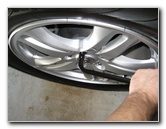 Tighten Lug Nuts |
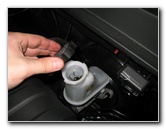 Check Brake Fluid Level |
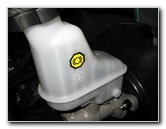 Replace Reservoir Cap |
|
Get into the driver's seat and pump the brake pedal a few times to restore brake line pressure. Then check the brake fluid level in the reservoir and verify that it is above the "MIN" (minimum) line. If it is low, pour in some new DOT 3 fluid. Once the brake fluid level is correct, replace the brake fluid reservoir cap. To break in your new brake pads, just drive normally for the first few hundred miles while trying to avoid any hard or "panic" stops. It's also a good idea to regularly inspect your garage or driveway for drops of brake fluid which may indicate a leak, verify the brake fluid level in the reservoir, and also check that the lug nuts are still properly tightened a few days later. For more,
visit my
Hyundai Santa Fe SUV
Repair & Maintenance Guides page. |
||
| If you found this guide to be helpful,
please consider making a small donation by clicking on the PayPal.com
"Donate" button located to the right of this paragraph. Thank you!
(Note: I am not a registered charity. Donations are not tax deductible.) |

